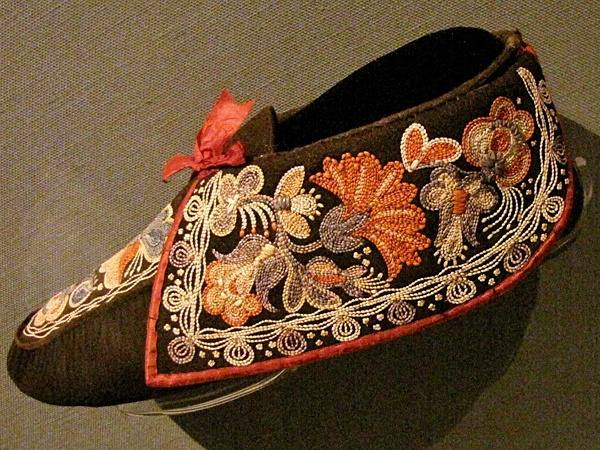When such a metaphysical spirit permeates everything, all society cannot but grow in quality and excellence. The lawyer presents a magnificent legal brief or a cobbler searches for a marvelous shoe for the sake of the beauty of their actions. The artist—so sensitive to such an outlook—produces his masterpiece and dies content even though he be not rich. Even the most modest of men, generally speaking, pursued their crafts as if they were arts and came to be great appreciators of beauty.

Huron moccasins c. 1830. The design elements have Euorpean origins that were taught to the Huron women by the Ursuline nuns in colonial Quebec. Because of the rarity of silk, dyed moose hair was used for the embroidery work.
Indeed, writes Lewis Mumford, “The purpose of art has never been labor-saving but labor-loving, a deliberate elaboration of function, form, and symbolic ornament to enhance the interest of life itself.”* And in the practice of this art, the act of labor becomes a veritable prayer.
Such an economy involved arduous effort, but God rewarded this sacrifice by conferring upon society the flowering of what we consider the better things of life: education, books, art, music, charity, and culture. All these rewards, Ballwin claims, “were, in the Middle Ages, the very paving, so to speak, of the Way of the Cross.”**
Such artistic production finds little resonance in an industrialized world based on frenetic intemperance and unbridled consumption. However, this spirit of immolation and abnegation, found in the Way of the Cross, is like the ballast of a ship or the brake of a car. It puts things in order and gives stability to economy. With this ballast, the “Way of the Cross” economy produced results beyond all expectations and gave value, meaning, and beauty to all things human. With God’s grace, it could do so again.
* Lewis Mumford, The Pentagon of Power. Vol. 2 of The Myth of the Machine (New York: Harcourt, Brace, Javanovich, 1970), 137.
** Summerfield Ballwin, Business in the Middle Ages (New York: Cooper Square Publishers, 1968), 68.
John Horvat II, Return to Order: From a Frenzied Economy to an Organic Christian Society—Where We’ve Been, How We Got Here, and Where We Need To Go (York, Penn.: York Press, 2013), 333-4.















